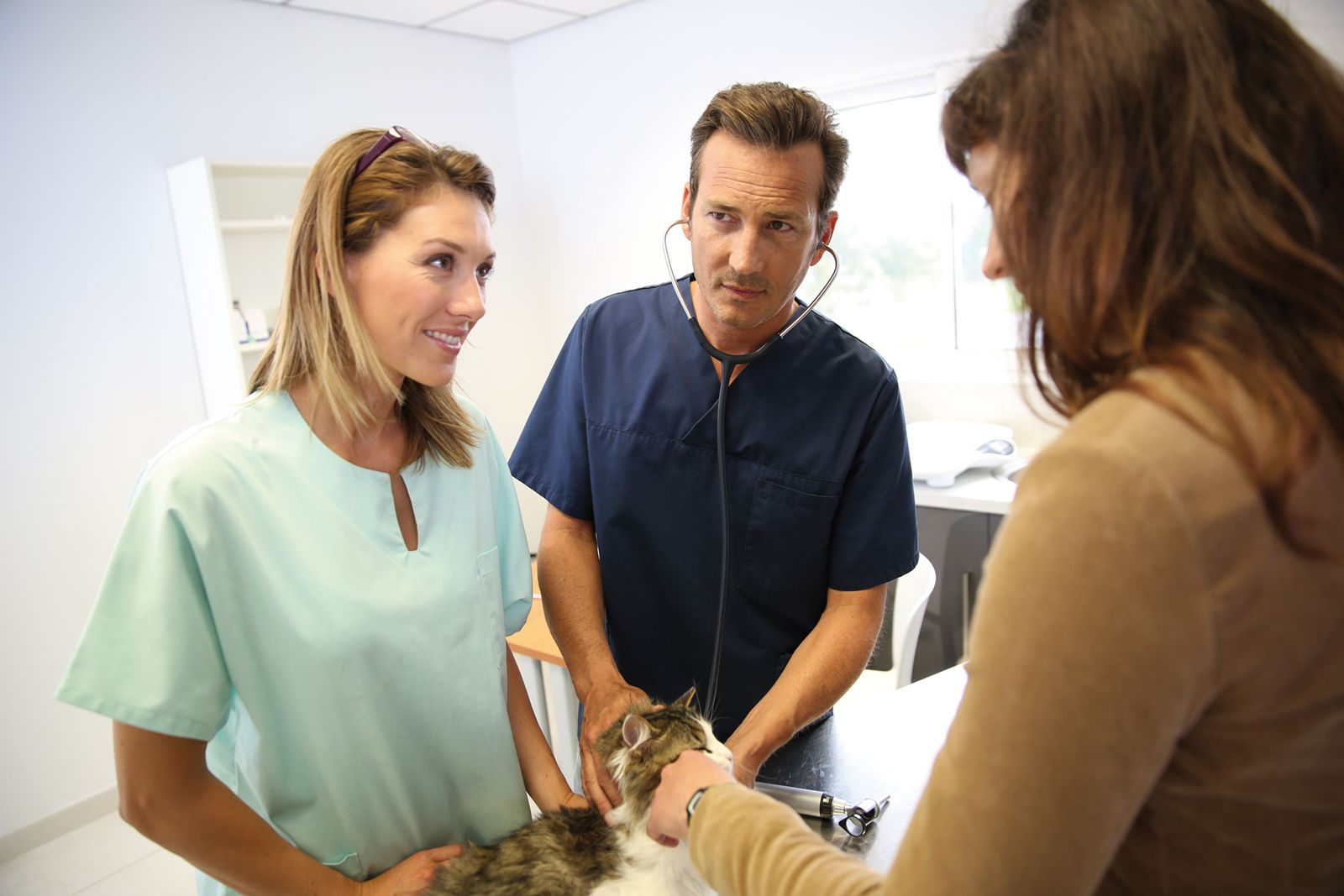Being a good vet (Part 2)
This part will cover the art of communication, especially when dealing with pet owners, because nothing is more frustrating than a lack of compliance when treating an animal.

Key Points
Skills in client communication have an impact on compliance and therefore on the benefit of your consultation.
As a young vet you can sometimes challenge the status quo, especially in the area of ethics.
Basic rules in client communication
Being a good vet from a medical point of view is the one thing that we should have learned at vet school, being a good communicator is something that we have to learn along the way. Unless we have a good mentor, communication skills are usually developed by a trial-and-error process during daily practice. Good communication is essential to build trust, to place and sell veterinary services and products, and to create value in the eyes of the client. Establishing good client communication is actually quite easy if you follow some basic rules! (Table 1).| Do´s | Don'ts |
|---|---|
| Greet client and pet warmly | Mumble a greeting and call them with a hand signal |
| Smile | Appear grim or distracted |
| Make and maintain eye contact | Look everywhere but the client |
| Ask what you can do for the client & listen | Start your examination of the patient |
| Speak clearly and accentuated | Mumble something incomprehensible |
| Explain what you are doing during the examination | Do a “robotic” exam without comments |
| Explain in normal phrases and translate medical terms | Speak in highly technical terms like a scientist |
| Explain that you can´t hear them when using the stethoscope | Ignore the client and what they are trying to tell you |
| Summarise your findings, get feedback and discuss options with the client | Just go on to treat the animal, leaving no room for explanations and feedback |
| Hand out a written report | Leave the client to memorise everything you have said |
| Say a warm “thank you” for the client´s visit | Just say a short goodbye |
Rule n°1 – A client is just a client
Always be conscious of your role as a veterinary scientist and be aware that your clients are depending on you to translate your medical language into normal, everyday words for them to understand and follow. You may have the impression that clients are able to grasp the content of your explanations just because they don´t question you, but that assumption can be risky because sometimes they are just too stressed or too overwhelmed to ask. To facilitate understanding, modify your language so that it connects with the general public, learn to translate technical terms and become “bilingual” (Figure 5). You should check their understanding by getting feedback whenever you have explained something or made an offer to your clients. Simply ask “How does that sound for you?” and give your customers some time to answer. They will tell you what more they want to know and need from you.

Rule n°2 – Science is #1
During our studies as a “vet to be”, science becomes the most important issue, especially when we are talking about passing exams or embarking on a career at university. When we go into practice, the science remains as the basis for good veterinary medicine. However, it is not enough on its own when it comes to creating a good relationship with your customers.
Communication specialists state that good communication is more than merely transporting scientific facts from a sender (you) to a receiver (your client). To pave the way for a motivating dialogue, your first action is to establish a positive relationship. Your “door-opener” should be to smile, make eye contact, ask the client “What can I do for you today?” and then to listen (Figure 6).
Don´t interrupt and don´t worry, clients don´t usually talk for hours on end. Using this approach you build trust and give the client the feeling that they are really important, which prepares your customers perfectly for the remaining parts of the consultation and the offers you are going to make.

Rule n°3 – Use a consultation strategy
A consultation strategy is something you should develop and use consistently throughout your professional career. It forms a framework for your client interactions and ensures that all your customers get the best individual offer and service you can provide. A concise strategy impacts well on your clients, creates value during the consultation and helps you deliver the best for their pet. If you do it right, your clients will want to come back again and they will form a really strong bond with you as their primary healthcare provider.
Setting up a consultation strategy is straightforward if you include the following points and once you have practised this strategy you will actually save a lot of time:
- Welcome the client and ask them about their pet and its requirements (see Rule n°2).
- Listen to the client, take notes and first decide what can be accomplished in the current consultation and what issues have to be postponed to a new appointment. Before you move on, you should go over your notes with the client again, the choices you have made and get feedback and approval from them.
- Perform a comprehensive clinical exam “from nose to tail”, commenting in short and clear messages what you are doing, why, and reporting your results.
- After the exam, you should present the client with a short and precise summary together with your solutions and offers (diagnostics, services and products). At this stage, it is crucial not to overburden the client with too much information – give them a maximum of three important issues together with solutions and the benefits their pet will experience if they agree to your recommendations.
- Now it´s time to come to an agreement and a commitment on the client´s part as to which services and products are prescribed and sold to them. Get feedback on your offers by asking “How does that sound for you?”. The client may have some additional questions, but if not, or after answering them, you can move ahead to perform diagnostics, to treat the animal, to explain medication and nutrition and to schedule the next appointment(s).
- Prepare a written consultation report for the client to take home. Sum up the key issues and the outcome of your consultation together with your prescriptions and the next appointment. This ensures important issues (nutrition, medication, other measures) won´t be forgotten, and the good pet healthcare message is transferred to the owner´s home so that the client’s family will also be involved in the consultation and its outcome.
- When everything is completed, you should always end the consultation with a “thank you” to the client for choosing you as their doctor (there are a lot of others around) and give your best wishes for the pet´s well-being. Then you say goodbye to the owner and pet, and tell them that you are looking forward to their next visit.
Getting owners to comply with your recommendations
The importance of a clear recommendation
| The CRAFT equation (C=R+A+FT) |
| The AAHA summarised the process of achieving high levels of compliance with veterinary recommendations in the CRAFT equation: |
| C=R+A+FT |
|
Where:
|
Acceptance by the client
Following on from the clear recommendation by the vet and, if appropriate, reinforcement from other team members, the next most importance phase is the acceptance by the client. It is a sad fact of life that even when the vet makes a clear recommendation many clients will still choose not to act upon it. This is because whilst they may have heard the recommendation they have not accepted it. It is all too convenient to blame this failure on the client, but this is to oversimplify the acceptance process.
Acceptance requires that the client not only fully understands the recommendation, but that they also understand why they need to act now, and the benefits to them and their pet of doing so. Achieving acceptance may take some additional steps:
Make sure that you have translated your recommendation into a firm offer (and if appropriate an estimate of the cost) so that the client is clear about what is required of them.
Explain the benefits to them and/or their pet of taking this action at this time, and where appropriate, the consequences of not acting.
It is important that the client understands both the recommendation and the benefits, so make it clear to the client that you are happy for them to ask you questions to clarify their understanding, and to allow you to respond to their concerns.
Always take the time to get a clear commitment from the client to the agreed plan of action, before discussing the arrangements for the treatment to take place.
Using the whole practice team to improve compliance
The AAHA created the “CRAFT” model to help practices to identify the key steps to achieving compliance; that is a clear recommendation, reinforced by the healthcare team, leading to acceptance by the client, and then followed through by the healthcare team over time.
The most important message from the studies is that compliance is a team game:
1. Reinforcing recommendations
To ensure that the team can reinforce and support the veterinary surgeon’s recommendations, they have to know what these are likely to be, and this is the role and purpose of practice protocols and procedures. Protocols ensure that all clients receive a consistent message, and that staff feel able to make recommendations or to reinforce the recommendations of other members of the team without fear of contradiction.
Of course, if the clinicians within the practice hold differing views this can become confusing not just for clients, but also for the other members of the practice team. Part of the process of developing effective protocols is for the practice’s clinicians to agree how routine cases and conditions should be approached, taking account of the local levels of risk, emerging pharmaceuticals and developments in treatments. It is worth remembering that whilst we can sometimes demonstrate outcome improvements using different clinical approaches, these differences are often small when considered against the very low level of compliance that the absence of a protocol creates.
The positive result of effective protocols has been demonstrated by various studies undertaken by a number of drug companies, all of which have shown that the development and implementation of effective protocols for routine treatments (for example, for parasite control) have had a significant positive impact on overall rates of compliance.
2. Follow through by the practice team

Ethics in business and veterinary medicine
As previously mentioned, the private practice of veterinary medicine is an activity that is very demanding professionally. It is expected that young veterinary surgeons quickly become experts in the different medical disciplines, that they be skilful in communicating, that they empathise with both the patient and the owner, that they do not forget the financial situation of the clinic that employs them, and so on. In short, this is a colossal challenge for any young professional.
Some studies on the mental health of the profession note a disturbingly high rate of stress and psychological problems amongst veterinary surgeons. Qualitative research about the most stressful or disagreeable factors for clinical veterinary surgeons shows that the main problems are;
- Interactions with difficult clients.
- Arguments with clients due to money.
- Client-patient conflicts of interest.
- Euthanasia and the resulting emotional support for owners (Figure 8).

Many experienced veterinary surgeons can describe stressful personal experiences that had an emotional impact on them such as:
- Owners who cannot (or say they cannot) pay for a treatment but who demand that the veterinary surgeon proceed with this on the basis of a supposed vocational or professional obligation
- Owners who question the suitability of a treatment plan proposed by the veterinary surgeon and who accuse him or her of being motivated by mainly economic reasons.
- Well-meaning persons who collect abandoned or injured animals and who confuse the veterinary clinic with a charitable institution.
- Owners who request euthanasia for “convenience reasons” that are not personally acceptable to the veterinary surgeon.
It is impossible to offer the young veterinary surgeon a magic wand that resolves these complicated situations in a stress-free manner, but the following thoughts can be helpful:
1. Seek advice or support from your boss, your colleagues, vets in other practices, etc. whenever you face one of these heartbreaking dilemmas. Do not keep it to yourself, you need to share your feelings and listen to people who have experienced similar situations before.
2. Whenever you feel or perceive that there is a mismatch between your principles and those of your practice, you should raise the issue at the appropriate time and in the appropriate manner: not challenging or criticising, but rather asking and trying to understand.
3. The veterinary clinic is a business activity with very tight profit margins. Most veterinary clinics in the world obtain profits of less than 10-20% of their revenues. And this is before considering the impact of investments, financial expenses and taxes. In addition, in many countries, the veterinary surgeons have salaries that are appreciably less than those of other qualified professionals with comparable levels of requirements and responsibilities. Therefore, when a veterinary clinic charges for the services it provides, it is not breaching any ethical or deontological standard whatsoever, nor is it betraying any vocation... It is simply fighting for its own survival as an organisation.
4. We are veterinary surgeons, not managers of our clients’ personal finances. There is no scientific study that allows us to predict the degree of a person’s emotional attachment to their pet on the basis of their social class, their origin, the clothes they wear or the car they drive. It is therefore not incumbent upon the veterinary surgeon to prejudge without asking what quality of medicine an owner wishes to give their pet. The veterinary surgeon’s obligations are to be honest, objective and clearly present the medical options available. Always start with the best option as the first recommendation, and if the owner’s economic conditions make this unrealistic, then only propose alternatives that, whilst not optimal, do not compromise either your own integrity or the patient’s well-being.
For many young vets, euthanasia is the most difficult situation to manage with the pet owner.
5. We have to learn to diagnose the reasons behind an owner’s decision to say “no”. When an owner rejects the treatment plan proposed by their veterinary surgeon, there may be multiple reasons and we must ask them why. Here are some typical responses:
- “I don’t want to spend this amount of money on a pet”. “I love my dog, but in the end it’s a dog. It doesn’t seem right to spend this money on a pet.” This is a legitimate posture that we should respect without putting pressure on the client.
- “I don’t have the money. I can’t afford it. If only I could afford it.” These are cases in which extending credit to the clients can be a very good solution, albeit one that has associated risks that must be managed. Many veterinary practices have been identifying credit solutions that they can offer to their clients, frequently through agreements with financing institutions.
- “I don’t think this treatment is the solution to my pet’s problems.” “This vet does not inspire me with confidence.” In this situation, which occurs more often than we think, the client will usually give economic reasons to reject a treatment, but the real cause for their rejection stems from poor communication by the vet.
The real challenge for the young vet lies in acquiring the skill and sensitivity to be able to have a sincere conversation with clients that say “no”, and to understand what is behind each one of these responses.
Conclusion
Becoming a “good vet” involves first choosing an area in which you are comfortable to work. Then, acquiring the necessary know-how will require the support from other experienced veterinary surgeons. Part of the equation is good communication with the pet owner, and finally it is essential to have some awareness of what constitutes a good work-life balance and how to achieve it.Philippe Baralon
DVM, MBAFrance
Dr. Baralon graduated from the École Nationale Vétérinaire of Toulouse, France in 1984 and went on to study Economics (Master of Economics, Toulouse, 1985) and Business Administration (MBA, HEC-Paris 1990). He founded his own consulting group, Phylum, in 1990 and remains one of its partners to this day, acting primarily as a management consultant for veterinary practices in 30 countries worldwide. His main areas of specialization are strategy, marketing and finance, and he is also involved in training veterinarians and support staff in the field of practice management through lectures and workshop, as well as benchmarking the economics of veterinary medicine in different parts of the world. A prolific author, he has authored more than 50 articles on veterinary practice management.
Antje Blattner
DVMGermany
Dr. Blaettner grew up in South Africa and Germany and graduated in 1988 after studying Veterinary Medicine in Berlin and Munich. She started and ran her own small animal practice before undertaking postgraduate training and coaching course at the University of Linz, Austria and then founded “Vetkom”. The company provides training to veterinarians and veterinary nurses in practice management in subjects such as customer communication, marketing and other management topics. Dr. Blaettner also is editor for two professional journals, “Teamkonkret” (for veterinary nurses) and “Veterinärspiegel” (for veterinarians).
Pere Mercader
DVM, MBASpain
Dr. Mercader established himself as a practice management consultant to veterinary clinics in 2001 and since then has developed this role in Spain, Portugal and some Latin-American countries. His main accomplishments include authoring profitability and pricing research studies involving Spanish veterinary clinics, lecturing on practice management in more than 30 countries, and authoring the textbook “Management Solutions for Veterinary Practices” which is published in Spanish, English and Chinese and has sold worldwide. In 2008, he co-founded VMS (Veterinary Management Studies), a business intelligence firm that provides a benchmarking service for more than 800 Spanish veterinary practices. Dr. Mercader was also a co-founder of the Spanish Veterinary Practice Management Association (AGESVET) and served on its board for eight years.
Mark Moran
MBAUnited Kingdom
Mark Moran has been a consultant to the veterinary profession for the last 19 years, providing business mentoring and support for veterinary clinic owners and key staff. His work involves helping veterinary practices create effective working environments, with happy staff, that meet the business owner’s values and expectations. He has a special interest in helping practices to improve their patient’s compliance to veterinary recommendations by making better use of data systems.
Other articles in this issue
Share on social media